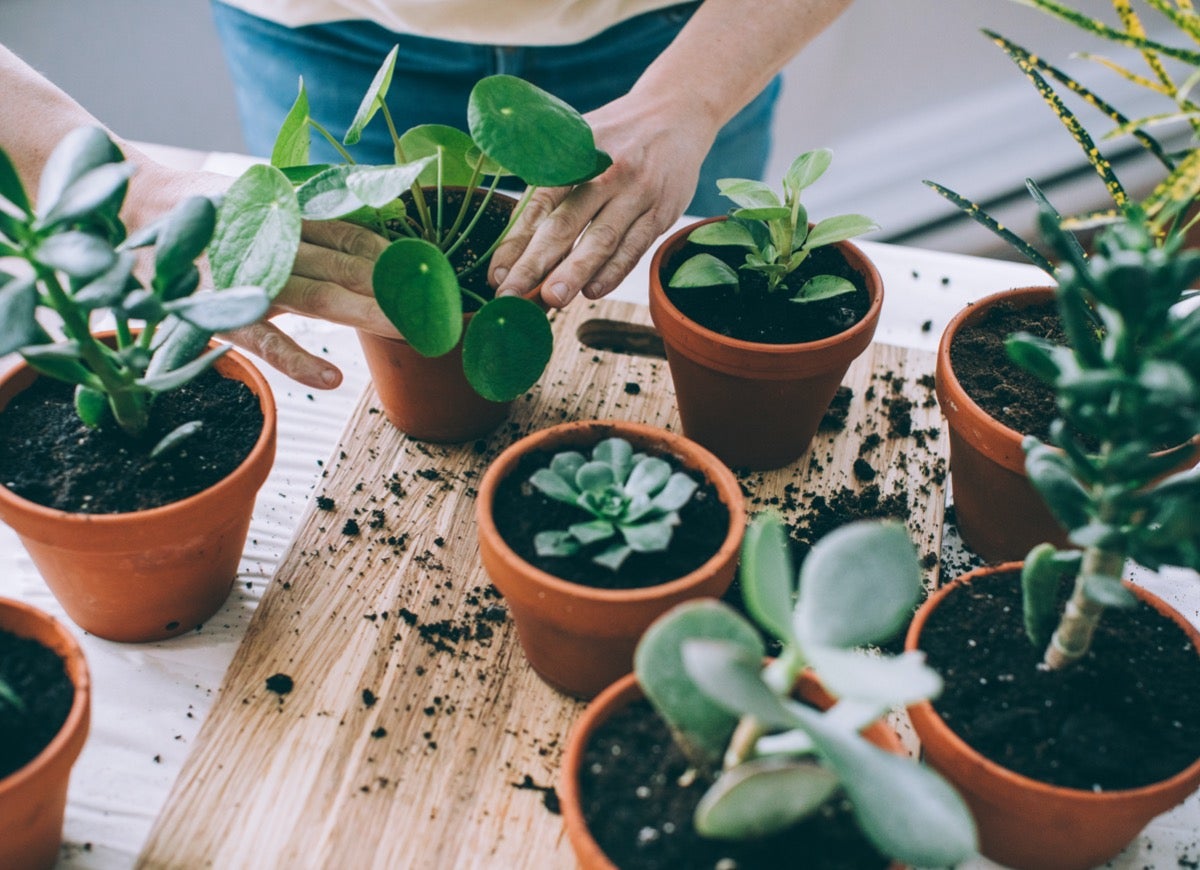We may earn revenue from the products available on this page and participate in affiliate programs. Learn More ›
A Rooting Tooting Good Time

According to Merriam-Webster, to propagate means “to cause to…increase by sexual or asexual reproduction.” This article deals with the latter method, since most houseplants grow from divisions or cuttings rather than seeds.
For success with cuttings, use sharp, sterilized pruning shears, garden scissors, or a utility knife and make cuts at a 45-degree angle. Allow succulent divisions or cuttings a couple days for their wounds to callus over before you pot them up again, and keep new transplants out of direct sun for about 10 days to allow them time to recover.
ZZ Plant (Zamioculcas zamiifolia)

Before you attempt to propagate a houseplant with cuttings, consider whether your “parent plant” really is a single plant or actually several crowded together in the same pot for a fuller look—which often is the case with the ZZ. Though its name might sound like a snorefest, this recently introduced plant can make more plants easily. Simply pull it from the pot and gently tug its rhizomes apart before giving each specimen its own container full of potting soil.
Related: The Best Gardening and Plant Identification Apps for Your Smartphone
Burn Plant (Aloe vera)

The burn plant does all the work of propagation for you by “whelping” pups around its base. They can be weaned from their mother, each to be top dog in its own container, though you can let her keep a few mama’s boys if you want. Accomplish this type of division by easing the root balls apart, using a sharp knife to slice where necessary.
Queen’s Tears (Billbergia nutans)

As with succulents, some bromeliads make offsets—this one so much so that it often is called “friendship plant” for the ease with which growers can share it. Keep in mind that the original queen will die after she flowers. Hence the tears, which actually are droplets of nectar in those blooms! You can divide the plant and repot the royal offspring when they are 6 inches tall.
Spider Plant (Chlorophytum comosum)

The spider plant also makes babies, but hers dangle from her “apron strings” (runners called stolons). Encourage a spiderling to put down roots of its own by setting a small container full of potting soil beside the mother plant. Bend a stolon and pin a plantlet—with its knobby base down—onto the surface of the soil with a landscape staple. Leave it in place until it becomes rooted to the spot—after which you can cut its apron string.
Mother of Thousands (Kalanchoe daigremontiana)

If you own this kalanchoe, you know it wears children like ruffles around the edges of its leaves and opportunistically drops them into the soil of other nearby plants, where they quickly take root. Not a nurturing parent, this mother actually inhibits the growth of babies located in the same pot as mom, while those babies can have a similar allelopathic effect on other plants. Place them on the surface of cactus potting soil and they’ll make themselves at home.
Flaming Katy (Kalanchoe blossfeldiana)

Another type of kalanchoe, Katy can grow lanky after blooming, but often considerately makes new roots at her joints (called adventitious or aerial roots). Cut one of those stems off below the roots and position it in a pot of cactus potting mix so that the roots are beneath the surface. Alternatively, you can place a cutting without roots in a juice glass containing an inch or so of water, keeping it in bright indirect light until it produces some roots.
Swiss Cheese Plant (Monstera deliciosa)

Speaking of aerial roots, the highly popular Swiss cheese plant also makes those—or at least nubs that are the beginnings of roots—in its leaf nodes. Although NUB stands for “non-useful body” in the Navy, it can be the “natural useful beginning” of a new monster plant, too! If you take a 4- to 5-inch cutting, strip off its lower leaves, and place it in a glass of water, the nubs on the stem should root for you.
Coleus (Plectranthus scutellarioides)

If your favorite color is all of them, you’ll be happy to hear multihued coleus also roots quickly in water. Take a cutting 4 to 6 inches long, snipping it between two leaf nodes. Remove the lower leaves, allowing no more than four near the tip to remain. Place the cutting in a container and add enough water to cover a couple nodes at its base. If kept in bright, indirect light, the cutting should root in a couple weeks.
Begonia (Begonia spp)

Wax begonia roots easily in water under the same conditions coleus does. In fact, almost all begonias get to the root of the matter quickly, though you should follow a different procedure for the large-leafed Rex type. Although this sounds cruel, you’ll need to pin one of those leaves down to the surface of potting soil and slash its veins. Make each ½-inch cut across—instead of parallel to—a main vein, and mini-Rexes should pop up eventually.
African Violet (Saintpaulia ionantha)

Speaking of leaves, you can take a leaf from your grandmother—either figuratively or literally—and root it to produce a new African violet. To do that, fill a small juice glass nearly to its top with water and cover it with a small piece of aluminum foil. Then punch a hole in that foil with a pencil and suspend the leaf in the hole so that its 1/2-inch-long stem dangles into the water while the leaf itself remains above.
Related: The One Rule of (Green) Thumb When Decorating With Houseplants

Want to Banish Weeds From Your Lawn Once and For All?
Join our FREE webinar event to learn how to keep weeds at bay this spring, and get a chance to ask lawn care and landscaping experts your weed control questions.

